Click on images to enlarge
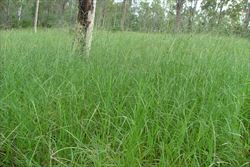
infestation (Photo: Sheldon Navie)

infestation (Photo: Sheldon Navie)
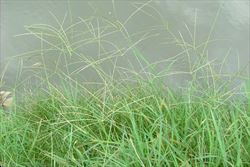
habit (Photo: Sheldon Navie)
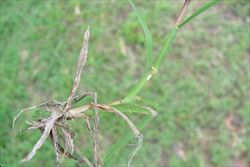
stems and leaves (Photo: Sheldon Navie)
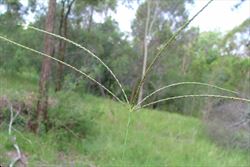
digitate seed-head (Photo: Sheldon Navie)
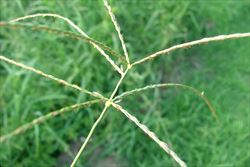
sub-digitate seed-head (Photo: Sheldon Navie)
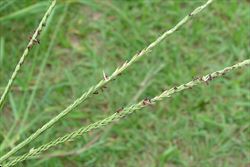
close-up of flower spikelets (Photo: Sheldon Navie)
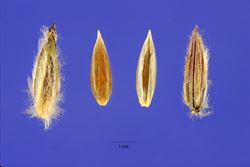
close-up of seeds (Photo: Steve Hurst at USDA PLANTS Database)
Scientific Name
Digitaria eriantha Steud. subsp. pentzii (Stent) Kok
Synonyms
Digitaria decumbens StentDigitaria eriantha Steud.Digitaria eriantha Steud. 'Pangola'Digitaria pentzii Stent
Family
Gramineae (South Australia)Poaceae (Queensland, New South Wales, the ACT, Victoria, Tasmania, Western Australia and the Northern Territory)
Common Names
common finger grass, common fingergrass, crabgrass, digit grass, digitaria, digitgrass, finger grass, Pangola fingergrass, Pangola grass, Pangolagrass, smuts finger grass, smuts fingergrass, woolly finger grass, woolly fingergrass
Origin
Native to southern Africa (i.e. Angola, Mozambique, Zimbabwe, Botswana, Namibia, Swaziland and South Africa).
Naturalised Distribution
Naturalised in eastern Australia (i.e. in south-eastern, central and northern Queensland) and in some parts of northern Western Australia.
Also naturalised overseas on some Pacific islands (i.e. Hawaii and the Galapagos Islands).
Habitat
A weed of footpaths, gardens, parks, disturbed sites, waste areas, crops, pastures, open woodlands, grasslands, waterways (i.e. riparian areas) and coastal environs.
Habit
A long-lived (i.e. perennial) tufted grass with spreading (i.e. decumbent) or semi-upright (i.e. ascending) flowering stems usually growing 40-120 cm tall. It sometimes also produces creeping runners (i.e. prostrate stolons).
Distinguishing Features
Stems and Leaves
The branched or unbranched stems are mostly hairless (i.e. glabrous) and their joints (i.e. nodes) are usually brownish in colour. These stems sometimes produce roots where their joints come into contact with the soil.
The alternately arranged leaves consist of a leaf sheath at the base, which encloses the stem, and a spreading leaf blade. The leaf sheaths are hairless (i.e. glabrous) or sparsely covered with long spreading hairs that have wart-like swellings at their base (i.e. tuberculose hairs). Where the leaf sheath meets the leaf blade there is a tiny membranous rim topped with hairs (i.e. ciliate ligule) 2-4 mm long. The leaf blades (5-20 cm long and 2-7 mm wide) are long and narrow (i.e. linear) with entire margins and pointed tips (i.e. acuminate apices). They are hairless (i.e. glabrous) and their margins are usually rough to the touch (i.e. scabrous).
Flowers and Fruit
The greenish seed-heads (i.e. inflorescences) are borne at the tips of the stems and usually consist of 3-10 fine branches (i.e. racemes) arranged along a short section of stem less than 5 cm long (i.e. they are digitate or sub-digitate). Each of the flowering branches (5-20 cm long) bears numerous tiny flower spikelets. These flower spikelets (2.2-3.5 mm long) are borne on very short stalks (i.e. pedicels) 0.5-3 mm long and held close to the stems (i.e. they are appressed). These spikelets are somewhat elongated in shape (i.e. broadly lanceolate) and may be hairless (i.e. glabrous) or variously hairy (i.e. pubescent). They consist of a pair of bracts (i.e. glumes) and two tiny flowers (i.e. florets), only one of which is fully formed. The lower glume is very small (0.2-0.5 mm long), while the upper glume is larger (0.9-2 mm long). The fully-formed floret has two floral bracts (i.e. a lemma and palea), three stamens, and an ovary topped with a two-branched feathery stigma. Flowering occurs mostly during summer and autumn.
The flower spikelets fall from the seed-head entire and the small seed (i.e. grain or caryopsis) remains enclosed in the floral bracts.
Reproduction and Dispersal
This species reproduces by seed, and also vegetatively via its creeping runners (i.e. stolons).
Its seeds may be spread by water, animals or in contaminated soil and agricultural produce. The runners spread laterally, enabling this species to form large colonies.
Legislation
This species is not declared under any state or local government legislation in the region.
Management
As this species is not a declared plant, its control is not required and there are no restrictions on its sale or cultivation. However, it is an environmental weed and should be controlled in sensitive bushland and conservation areas.
Similar Species
Pangola grass (Digitaria eriantha) is very similar to summer grass (Digitaria ciliaris) and violet crabgrass (Digitaria violascens). These species can be distinguished by the following differences:
- Pangola grass (Digitaria eriantha) is a long-lived (i.e. perennial) plant and often produces roots at its stem joints (i.e. nodes). Its flowers spikelets are relatively small (2.2-3.5 mm long).
- summer grass (Digitaria ciliaris) is a short-lived (i.e. annual) plant and usually does not produce roots at its stem joints (i.e. nodes). Its flowers spikelets are relatively small (2.5-3.5 mm long).
- violet crabgrass (Digitaria violascens) is a short-lived (i.e. annual) plant and usually does not produce roots at its stem joints (i.e. nodes). Its flower spikelets are very small (less than 2 mm long).
Pangola grass (Digitaria eriantha) is also similar to several of the native digit grasses (i.e. Digitaria spp.). For a more in depth key to the differences between these species see a specialist text on the grasses (e.g. Ausgrass: an interactive key to Australian grasses).
Notes
Pangola grass (Digitaria eriantha subsp. pentzii) is regarded as an environmental weed in south-eastern Queensland, and it appears on the list of the top 200 most invasive plants for this region. It has escaped cultivation and forms dense populations along waterways (i.e. in riparian areas) and in open woodlands. It has also been recorded as a weed of beaches in Sarina Shire in northern Queensland, where it dominates areas and excludes native species.

